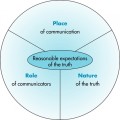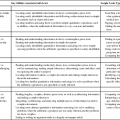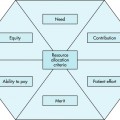After completing this chapter, the reader will be able to perform the following: • Name a variety of ethical challenges for imaging professionals arising from the following areas: • Imaging’s example for health care in the 21st century • Radiographic interpretation and testing • Newer levels of imaging professional education and responsibility • Identify complex legal and ethical issues raised by changing technologies. • State the liability issues associated with the new level of responsibility of the new position of radiologist assistant. • Identify the inability of law to act proactively in changing technologic fields. • Name the guidelines provided by professional organizations to aid in ethical decision making in controversial situations. • State the importance of participation in professional organizations. Former Speaker of the House Newt Gingrich, founder of the Center for Health Transformation, and Robert Egge, director of the Accelerating Health Innovation Project at the center, recognize the need for transforming the American health system for the 21st century. They explain that Hurricane Katrina is an example of how ineffectively the health care system functioned and that rebuilding a better system is imperative. Gingrich and Egge further explain1: Numerous new technologies have been developed and have become valuable tools in diagnosis and treatment. No sooner has a new technique, a new modality, or a new combination of existing modalities hit the headlines than yet another exciting imaging innovation has claimed its place. As a new technology is born, so are the ethical and sometimes legal complications (Table 10-1). These complications or dilemmas will call for critical thinking and problem solving as imaging professionals recognize that new technologies provide new information that requires new and sometimes difficult decisions for the professional and the consumer. Decisions concerning wellness, research, early detection, archiving, monitoring of disease processes, prediction of future health problems, and lulling of consumers into a false sense of security may complicate ethical and legal issues. TABLE 10-1 NEW TECHNOLOGY OR NEW USES FOR OLDER TECHNOLOGY Imaging professionals have an obligation to the profession to maintain current knowledge and be critically aware of future technology and trends. Such maintenance and education require imaging professionals to read scientific journals and practice proper research methods. While reviewing various research materials, imaging professionals must analyze the data and practice critical thinking (see Box 1-2). Imaging professionals concerned with respect and stature in the health care community should consider the options available to them to encourage others to perceive them more positively. They should educate others about the profession and describe the creative and innovative processes they have undertaken and completed. Moreover, they should expend the extra effort to describe their findings and experiences in established journals. Imaging educators should encourage or even require their students to perform and present research; unfortunately, the imaging sciences lag behind medicine and nursing in research and publishing. Professional journals, periodicals, and organizations are eager for imaging professionals and students to submit work. Given this desire for information and education, imaging professionals must look to the future and promote the recognition of the imaging sciences.2 Imaging professionals may find themselves involved with patients and families awaiting organ transplants; they may also have contact with donors and their families. The events surrounding organ transplantation are often emotional and must be handled with empathy and ethical awareness (Box 10-1). The AMA Council on Ethical and Judicial Affairs has outlined three principal ethical concerns of the physician and health care team—including the radiographer2: 1. Full discussion of the proposed procedure with the donor and recipient or responsible relatives or representatives is mandatory. The physician should be objective in discussing the procedure, disclosing known risks and possible hazards, and advising of the alternative procedures available. The physician should not encourage expectations beyond those justified by the circumstances. The physician’s interest in advancing scientific knowledge must always be secondary to the primary concern for the patient. 2. The transplantation of body organs should be undertaken only by physicians who possess special medical knowledge and technical competence developed through special training, study, and laboratory experience and practice. Transplants must take place in medical institutions with facilities adequate to protect the health and well-being of the parties to the procedure. 3. Transplantation of body organs should be undertaken only after careful evaluation of the availability and effectiveness of other possible therapy.
Overview of New Technology and Future Challenges
ETHICAL ISSUES
IMAGING’S EXAMPLE FOR HEALTH CARE IN THE 21ST CENTURY
NEW TECHNOLOGIES
New Technology or New Use
Imaging Ability
Positron emission tomography
Detection of Alzheimer’s disease
Magnetic resonance imaging
Real time
Assessment of beating fetal heart
3D
Detection of pancreatic cancer
Diffusion
Prediction of cancer progress
Contrast enhanced
Detection of breast cancer
Computed tomography
Full body
Diagnostic overview
Multislice
Complement to coronary angiography
Ultrasound
Obstetric
Diagnostic and commercial
High intensity focused
Gene therapy and tumor destruction
Multimodality fusion imaging (positron emission tomography and single photon emission computed tomography)
Stem cell tracking and monitoring
Virtual colonoscopy
Diagnostic
Molecular imaging
Monitoring of disease treatments; detection of diseases in early development; tracking of effectiveness of new drugs
Nuclear medicine/cardiovascular
Visualization of heart damage up to 30 hours after brief interruption of blood or oxygen
Fusion picture archiving and communications (PACs)
Archiving of imaging information; multiple media options; more effective information access for health care providers and consumers
IMAGING PROFESSIONALS’ OBLIGATION TO RESEARCH
ETHICAL DILEMMAS OF TRANSPLANTS
![]()
Stay updated, free articles. Join our Telegram channel

Full access? Get Clinical Tree


Overview of New Technology and Future Challenges





